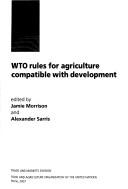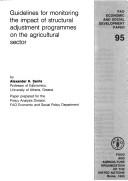Digital
ISBN: 9291908320 9291908339 Year: 2006 Publisher: Helsinki UNU-WIDER
Abstract | Keywords | Export | Availability | Bookmark
 Loading...
Loading...Choose an application
- Reference Manager
- EndNote
- RefWorks (Direct export to RefWorks)
Book
ISBN: 9789251058114 Year: 2007 Publisher: Rome FAO
Abstract | Keywords | Export | Availability | Bookmark
 Loading...
Loading...Choose an application
- Reference Manager
- EndNote
- RefWorks (Direct export to RefWorks)
"This report has two objectives. It assesses the nature and the extent of vulnerability among rural households in Tanzania with a particular focus on smallholder cash crop growers through exploring all risks, including the decline in commodity prices. It further explores the potential role for market based insurance schemes such as commodity price and weather based insurance to mitigate household vulnerability. The empirical analysis is based on two rounds of specifically designed representative surveys of farm households in Kilimanjaro and Ruvuma, two cash crop growing regions in the United Republic of Tanzania in 2003 and 2004. The contrasting experiences of a richer (Kilimanjaro) and a poorer (Ruvuma) region substantially enriches the policy guidance emerging from the report. "--Publisher's description.
Households --- Primary commodities --- Risk (Insurance) --- Rural poor --- Prices --- Tanzania --- Rural conditions.

Abstract | Keywords | Export | Availability | Bookmark
 Loading...
Loading...Choose an application
- Reference Manager
- EndNote
- RefWorks (Direct export to RefWorks)
Agriculture and state --- Economic development --- Produce trade --- World Trade Organization.
Book
Year: 2000 Publisher: Washington, D.C. : World Bank, Rural Development, Development Research Group,
Abstract | Keywords | Export | Availability | Bookmark
 Loading...
Loading...Choose an application
- Reference Manager
- EndNote
- RefWorks (Direct export to RefWorks)
Agricultural insurance --- Cocoa --- Crop Insurance --- Prices --- Crop insurance
Book
Abstract | Keywords | Export | Availability | Bookmark
 Loading...
Loading...Choose an application
- Reference Manager
- EndNote
- RefWorks (Direct export to RefWorks)

ISBN: 9251028648 9789251028643 Year: 1990 Volume: 95 Publisher: Rome: FAO,
Abstract | Keywords | Export | Availability | Bookmark
 Loading...
Loading...Choose an application
- Reference Manager
- EndNote
- RefWorks (Direct export to RefWorks)
Agriculture and state --- -Structural adjustment (Economic policy) --- -#ABIB:FAOdeposit --- 330.34 --- 330.34 Economische ontwikkeling. Regionale economische ontwikkeling --- Economische ontwikkeling. Regionale economische ontwikkeling --- Agrarian question --- Agricultural policy --- Agriculture --- State and agriculture --- Government policy --- Structural adjustment (Economic policy) --- #ABIB:FAOdeposit --- Third World: agricultural and food problems --- Developing countries: agricultural and food problems --- Agriculture and state - Developing countries --- Structural adjustment (Economic policy) - Developing countries
Book
Year: 2009 Publisher: [Washington, D.C. : World Bank,
Abstract | Keywords | Export | Availability | Bookmark
 Loading...
Loading...Choose an application
- Reference Manager
- EndNote
- RefWorks (Direct export to RefWorks)
"Food policy often depends on markets and markets depend on institutions. But how good do institutions have to be before reforms can be launched? Relying on well timed surveys of agricultural prices and a joint study by the Government of Bulgaria and the World Bank on agricultural market institutions, this paper presents evidence that performance in food markets improved following significant policy reforms in Bulgaria, although public institutions remained weak. This suggests that even though strong institutions are preferred to weak ones, it can be costly and impractical to delay policy reforms until work on strengthening institutions is finished. Still, measured performance varied by place and by commodity, suggesting that markets developed at different tempos and that the distribution of benefits from improved markets was uneven. This points to the need to address the costs of adjustment as policies change. The paper introduces a new approach to measure market performance based on composite-error techniques. "--World Bank web site.
Book
Year: 2007 Publisher: Washington, D.C., The World Bank,
Abstract | Keywords | Export | Availability | Bookmark
 Loading...
Loading...Choose an application
- Reference Manager
- EndNote
- RefWorks (Direct export to RefWorks)
Studies of risk and its consequences tend to focus on one risk factor, such as a drought or an economic crisis. Yet 2003 household surveys in rural Kilimanjaro and Ruvuma, two cash-crop-growing regions in Tanzania that experienced a precipitous coffee price decline around the turn of the millennium, identified health and drought shocks as well as commodity price declines as major risk factors, suggesting the need for a comprehensive approach to analyzing household vulnerability. In fact, most coffee growers, except the smaller ones in Kilimanjaro, weathered the coffee price declines rather well, at least to the point of not being worse off than non-coffee growers. Conversely, improving health conditions and reducing the effect of droughts emerge as critical to reduce vulnerability. One-third of the rural households in Kilimanjaro experienced a drought or health shocks, resulting in an estimated 8 percent welfare loss on average, after using savings and aid. Rainfall is more reliable in Ruvuma, and drought there did not affect welfare. Surprisingly, neither did health shocks, plausibly because of lower medical expenditures given limited health care provisions.
Agriculture --- Crime --- Crops and Crop Management Systems --- Economic Theory and Research --- Families --- Health Care --- Health Monitoring and Evaluation --- Health Services --- Health, Nutrition and Population --- Holistic Approach --- Hospitalization --- Macroeconomics and Economic Growth --- Mortality --- Poverty Reduction --- Quality of Life --- Risk Factors --- Rural Development --- Rural Poverty Reduction --- Unemployment
Book
ISBN: 9789251056103 Year: 2006 Publisher: Rome FAO
Abstract | Keywords | Export | Availability | Bookmark
 Loading...
Loading...Choose an application
- Reference Manager
- EndNote
- RefWorks (Direct export to RefWorks)
This report explores how farm productivity affects poverty, and how various factor market constraints affect farm productivity. The empirical analysis draws on representative surveys of farm households in Kilimanjaro and Ruvuma, two cash crop growing regions in the United Republic of Tanzania. Findings show that agricultural productivity directly affects household consumption and hence overall poverty and welfare. Analysis of allocative efficiency suggests that family labour is substantially overutilized, a sign of considerable excess labour supply. Use of intermediate inputs, on the other hand, is well below what is commensurate with the estimated value of their marginal productivities. An important reason for low input use is lack of credit to purchase inputs, but difficult access to the inputs themselves and, more broadly, a lack of connectivity to the economy, are also important impediments.
Cash crops --- Family farms --- Food supply --- Poverty
Book
Year: 2007 Publisher: Washington, D.C., The World Bank,
Abstract | Keywords | Export | Availability | Bookmark
 Loading...
Loading...Choose an application
- Reference Manager
- EndNote
- RefWorks (Direct export to RefWorks)
Studies of risk and its consequences tend to focus on one risk factor, such as a drought or an economic crisis. Yet 2003 household surveys in rural Kilimanjaro and Ruvuma, two cash-crop-growing regions in Tanzania that experienced a precipitous coffee price decline around the turn of the millennium, identified health and drought shocks as well as commodity price declines as major risk factors, suggesting the need for a comprehensive approach to analyzing household vulnerability. In fact, most coffee growers, except the smaller ones in Kilimanjaro, weathered the coffee price declines rather well, at least to the point of not being worse off than non-coffee growers. Conversely, improving health conditions and reducing the effect of droughts emerge as critical to reduce vulnerability. One-third of the rural households in Kilimanjaro experienced a drought or health shocks, resulting in an estimated 8 percent welfare loss on average, after using savings and aid. Rainfall is more reliable in Ruvuma, and drought there did not affect welfare. Surprisingly, neither did health shocks, plausibly because of lower medical expenditures given limited health care provisions.
Agriculture --- Crime --- Crops and Crop Management Systems --- Economic Theory and Research --- Families --- Health Care --- Health Monitoring and Evaluation --- Health Services --- Health, Nutrition and Population --- Holistic Approach --- Hospitalization --- Macroeconomics and Economic Growth --- Mortality --- Poverty Reduction --- Quality of Life --- Risk Factors --- Rural Development --- Rural Poverty Reduction --- Unemployment

 Search
Search Feedback
Feedback About UniCat
About UniCat  Help
Help News
News